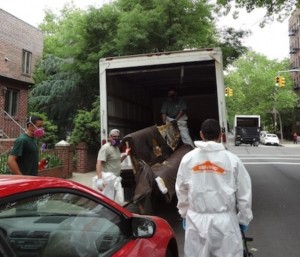The Animal Hoarder Next Door

Workers remove a couch chewed up by pets from the home of an animal hoarder in Queens. Photo courtesy of The Gothamist.
Gothamist reporter Sabine Heinlein and her husband had two elderly, female cousins as neighbors who kept a house full of cats and dogs.
But they never let the animals outdoors and when the neighbors opened their windows the stench of dog and cat feces and urine could be smelled in Heinlein’s nearby home.
Heinlein wrote about the years long push to get these neighbors to surrender their pets and clean their property, an effort that is ongoing.
For her article she interviewed National Association of Social Workers’ expert Mark Gaynor, MSW, ACSW, a therapist could has helped clients address hoarding problems. Gaynor also appeared on the Animal Planet reality program “Confessions: Animal Hoarding.”
Gaynor said the Heinlein’s neighbors fit the typical description of hoarders.
“The majority are single women over the age of 60 who have had a series of traumas in their lives,” he said. “They are not able to make healthy relationships with the world around them and probably had some earlier life experiences in which they were highly rewarded by animals. Animals are soothing to them.”
Advertisement
Leave a Comment
You must be logged in to post a comment.


